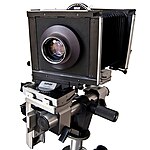
A single-lens reflex camera (SLR) is a camera that typically uses a mirror and prism system that permits the photographer to view through the lens and see exactly what will be captured. With twin lens reflex and rangefinder cameras, the viewed image could be significantly different from the final image. When the shutter button is pressed on most SLRs, the mirror flips out of the light path, allowing light to pass through to the light receptor and the image to be captured.

A rangefinder camera is a camera fitted with a rangefinder, typically a split-image rangefinder: a range-finding focusing mechanism allowing the photographer to measure the subject distance and take photographs that are in sharp focus. Most varieties of rangefinder show two images of the same subject, one of which moves when a calibrated wheel is turned; when the two images coincide and fuse into one, the distance can be read off the wheel. Older, non-coupled rangefinder cameras display the focusing distance and require the photographer to transfer the value to the lens focus ring; cameras without built-in rangefinders could have an external rangefinder fitted into the accessory shoe. Earlier cameras of this type had separate viewfinder and rangefinder windows; later the rangefinder was incorporated into the viewfinder. More modern designs have rangefinders coupled to the focusing mechanism so that the lens is focused correctly when the rangefinder images fuse; compare with the focusing screen in non-autofocus SLRs.

A view camera is a large-format camera in which the lens forms an inverted image on a ground-glass screen directly at the film plane. The image is viewed and then the glass screen is replaced with the film, and thus the film is exposed to exactly the same image as was seen on the screen.

A press camera is a medium or large format view camera that was predominantly used by press photographers in the early to mid-20th century. It was largely replaced for press photography by 35mm film cameras in the 1960s, and subsequently, by digital cameras. The quintessential press camera was the Speed Graphic. Press cameras are still used as portable and rugged view cameras.

135 film, more popularly referred to as 35 mm film or 35 mm, is a format of photographic film used for still photography. It is a film with a film gauge of 35 mm (1.4 in) loaded into a standardized type of magazine – also referred to as a cassette or cartridge – for use in 135 film cameras. The engineering standard for this film is controlled by ISO 1007 titled '135-size film and magazine'.

Leica Camera AG is a German company that manufactures cameras, optical lenses, photographic lenses, binoculars, rifle scopes and microscopes. The company was founded by Ernst Leitz in 1869, in Wetzlar, Germany.
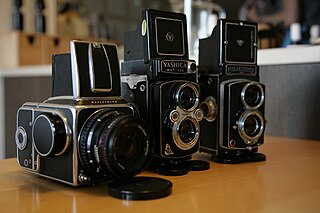
Medium format has traditionally referred to a film format in photography and the related cameras and equipment that use film. Nowadays, the term applies to film and digital cameras that record images on media larger than the 24 mm × 36 mm used in 35 mm photography, but smaller than 4 in × 5 in.

Large format refers to any imaging format of 9 cm × 12 cm or larger. Large format is larger than "medium format", the 6 cm × 6 cm or 6 cm × 9 cm size of Hasselblad, Mamiya, Rollei, Kowa, and Pentax cameras, and much larger than the 24 mm × 36 mm frame of 35 mm format.

Macro photography is extreme close-up photography, usually of very small subjects and living organisms like insects, in which the size of the subject in the photograph is greater than life size . By the original definition, a macro photograph is one in which the size of the subject on the negative or image sensor is life size or greater. In some senses, however, it refers to a finished photograph of a subject that is greater than life size.
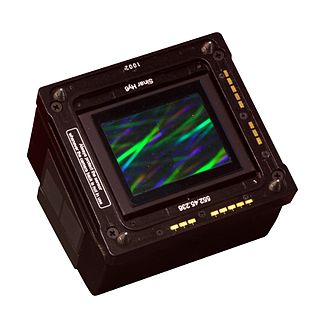
A digital camera back is a device that attaches to the back of a camera in place of the traditional negative film holder and contains an electronic image sensor. This lets cameras that were designed to use film take digital photographs. These camera backs are generally expensive by consumer standards and are primarily built to be attached on medium- and large-format cameras used by professional photographers.

Contax began as a German camera model in the Zeiss Ikon line in 1932, and later became a brand name. The early cameras were among the finest in the world, typically featuring high quality Zeiss interchangeable lenses. The final products under the Contax name were a line of 35 mm, medium format, and digital cameras engineered and manufactured by Japanese multinational Kyocera, and featuring modern Zeiss optics. In 2005, Kyocera announced that it would no longer produce Contax cameras. The rights to the brand are currently part of Carl Zeiss AG, but no Contax cameras are currently in production, and the brand is considered dormant.
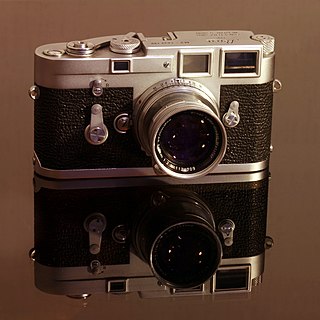
The Leica M3 is a 35 mm rangefinder camera by Ernst Leitz GmbH, introduced in 1954. It was a new starting point for Leitz, which until then had only produced screw-mount Leica cameras that were incremental improvements to its original Leica (Ur-Leica). The M3 introduced several features to the Leica, among them the combination of viewfinder and rangefinder in one bright window, like on the Contax II, a bayonet lens mount, and rapid film advance lever. It was the most successful model of the M series, with over 220,000 units sold by the time production of the M3 model ended in 1966.

Monorail cameras are view cameras with lens mount, bellows, and interchangeable viewing and film backs all fitted along a rigid rail along which they can slide until locked into position.
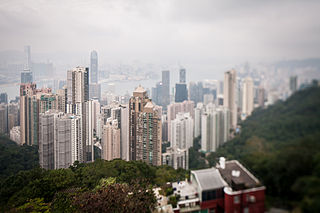
Tilt–shift photography is the use of camera movements that change the orientation or position of the lens with respect to the film or image sensor on cameras.

The Leica M8 is the first digital camera in the rangefinder M series introduced by Leica Camera AG on 14 September 2006. It uses an APS-H 10.3-megapixel Kodak KAF-10500 CCD image sensor.
Silvestri is an Italian manufacturer of professional photographic cameras and large format cameras.

The E-mount is a lens mount designed by Sony for their NEX and ILCE series of camcorders and mirrorless cameras. The E-mount supplements Sony's α mount, allowing the company to develop more compact imaging devices while maintaining compatibility with 35mm sensors. E-mount achieves this by:
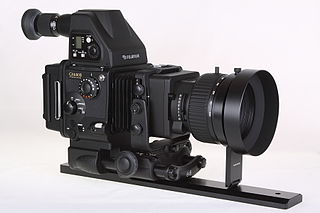
The Fuji GX680 is a series of single lens reflex system cameras for medium format film produced by Fujifilm with interchangeable camera lenses and interchangeable film holders for the unusual film format 6×8 cm on 120 and 220 roll film. The distinguishing feature of the Fuji GX680 is the articulating front standard, which runs on a rail connecting lens and camera body by a bellows; the interchangeable lens is permanently mounted to a lens board.

The Leica M is a full-frame digital rangefinder camera of Leica Camera AG. It was introduced in September 2012, and is the successor to the Leica M9 range of cameras. The M uses a 24-megapixel image sensor. The camera is the first M model to feature movie recording, and the first to have Live View, which allows the scene, as viewed through the lens, to be composed. The M can use most M- and R-mount lenses. Leica M cameras are made by hand in Portugal and Germany. There is also a version, the M Monochrom, with a monochrome, rather than colour, sensor.

Plaubel is a German camera maker, founded in November, 1902, by Hugo Schrader, who learned the technology of cameras and lenses as an apprentice at Voigtländer in Braunschweig in the late 1800s before being employed by a Frankfurt camera and lens manufacturer and distributor, Dr. R. Krügener, whose daughter he married. Hugo Schrader and his wife elected to open their own business, Plaubel & Co., as distributors and makers of cameras and lenses, naming it after his brother-in-law because he thought Plaubel was easier to remember than Schrader.


